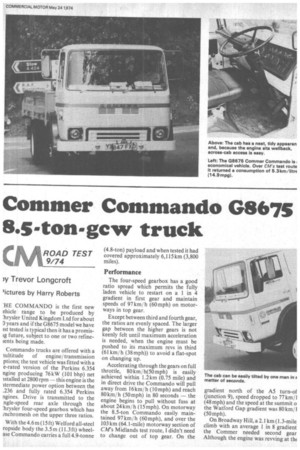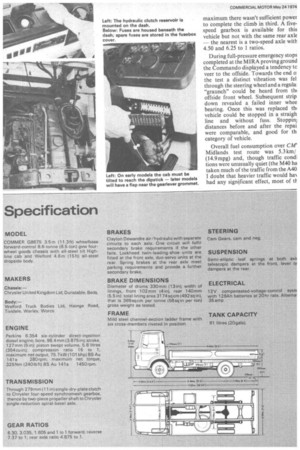Commer Commando G8675 8.5-ton gew truck
Page 43

Page 44

Page 45

If you've noticed an error in this article please click here to report it so we can fix it.
113904 4D TEST w Trevor Longcroft 'ictures by Harry Roberts TIE COMMANDO is the first new ehicle range to be produced by !hrysler United Kingdom Ltd for about 3 years and if the G8675 model we have tst tested is typical then it has a promisig future, subject to one or two refineLents being made.
Commando trucks are offered with a lultitude of engine! transmission ptions; the test vehicle was fitted with a e-rated version of the Perkins 6.354 ngine producing 76 kW (101 bhp) net istalled at 2800 rpm — this engine is the nermediate power option between the .236 and fully rated 6.354 Perkins ngines. Drive is transmitted to the ngle-speed rear axle through the 'hrysler four-speed gearbox which has inchromesh on the upper three ratios.
With the 4.6 m (15 ft) Welford all-steel ropside body the 3.5m (11.3 ft) wheelase Commando carries a full 4.9-tonne (4.8-ton) payload and when tested it had covered approximately 6,115 km (3,800 miles).
Performance
The four-speed gearbox has a good ratio spread which permits the fully laden vehicle to restart on a 1 in 4 gradient in first gear and maintain speeds of 97 km/ h (60 mph) on motorways in top gear.
Except between third and fourth gear, the ratios are evenly spaced. The larger gap between the higher gears is not keenly felt until maximum acceleration is needed, when the engine must be pushed to its maximum revs in third (61 km/h (38 mph)) to avoid a fiat-spot on changing up.
Accelerating through the gears on full throttle, 80 km/ h(50 mph) is easily achieved within 1.2 km (0.75 mile) and in direct drive the Commando will pull away from 16km/ h (10 mph) and reach 80 km/ h (50 mph) in 80 seconds — the engine begins to pull without fuss at about 24 km/ h (15 mph). On motorway the 8.5-ton Commando easily maintained 97 km/ h (60 mph), and over the 103 km (64.1-mile) motorway section of CM's Midlands test route, I didn't need to change out of top gear. On the gradient north of the AS turn-of (junction 9), speed dropped to 77km/ I (48 mph) and the speed at the summit o the Watford Gap gradient was 80 km/1 (50 mph).
On Broadway Hill, a 2.1 km (1.3-mile climb with an average 1 in 8 gradient the Commer needed second gear Although the engine was revving at ail maximum there wasn't sufficient power to complete the climb in third. A fivespeed gearbox is available for this vehicle but not with the same rear axle -the nearest is a two-speed axle with 4.50 and 6.25 to 1 ratios.
During full-pressure emergency stops completed at the MIRA proving ground the Commando displayed a tendency to veer to the offside. Towards the end o: the test a distinct vibration was fel through the steering wheel and a regula. "graunch" could be heard from ail offside front wheel. Subsequent strip down revealed a failed inner whee bearing. Once this was replaced thi vehicle could be stopped in a straigh line and without fuss. Stoppinl distances before and after the repai were comparable, and good for th category of vehicle.
Overall fuel consumption over CM' Midlands test route was 5.3km/ (14.9 mpg) and, though traffic condi tions were unusually quiet (the M40 ha taken much of the traffic from the A40 I doubt that heavier traffic would haN had any significant effect, most of th route was covered in either third or fourth gear.
The Commando ambled along effortlessly at 64km/ h (40) in top, and could pull satisfactorily from 32km/ h (20 mph) providing brisk acceleration was not required.
On the motorway section of the route the vehicle returned 4.8 km/1 (13.5 mpg) at an average speed of 94.1 km/h (58.5 mph).
Ride and handling
I couldn't fault the suspension. After driving around the exacting ride and handling course at MIRA at speeds often approaching 64 km/ h (40mph) without undue discomfort I felt sure that on-the-road performance would be good I was right.
Whether on motorway, good class dual-carriageway or 'B' classified roads there was no pitch or bounce and the cab was vibration free. Optional dampers had been fitted to the rear axle. No power steering option exists for the Commandos up to 8.5 tons gross and in my view the cam and peg steering unit is only just acceptable without assistance. As tested the front axle was loaded to 2.9 tonnes (2.85 tons), 0.35 tonnes below its plated gross. Had the weight distribution been more heavily biased to the front axle the steering would have been even heavier than it was. However, as tested, the steering was light enough for only minor manoeuvres on wide roads, but on narrower roads with tight bends and small roundabouts it proved tiresome; a firm grasp was needed on the steering wheel, the more so as the wheel approached full lock. For a vehicle likely to be engaged on delivery work with the close quarter manoeuvring that this entails I would expect Chrysler to specify power steering at least as an option.
The gear lever is nicely positioned relative to the driver, though the baulking mechanism gives a slightly notchy feel to an otherwise fast change. I was able to beat the synchromesh only once, when changing from first to second during maximum acceleration tests.
The brake and throttle pedals are very close together and though I didn't depress both in error it is easily possible. I was disappointed with the on-road braking performance which was not characteristic of the good response achieved during full-pressure brake tests. The brake pedal lacked progressive "feel" and felt spongy as if the hydraulic system required bleeding.
Several times when approaching junctions and tight bends I was unable to reduce speed quickly, even though I had applied the brakes in what seemed good time.
Driver comfort
The Highline cab is standard on the highway truck models and is a de-luxe version of the standard model fitted to tippers. Interior trim is neat and the approach to design workmanlike. Hopping in and out of the cab is easy with no need for any foot shuffling to get seated. The cab sits forward relative to the engine and there is sufficient space for two passengers.
The driver's seat has ample forward and back adjustment, though it is easy to rap one's knuckles against the park/secondary brake valve when moving the seat. The seat cushion is practically flat and offers no thigh support and after long spells at the wheel the base of my spine felt a bit sore.
Otherwise I could find little to criticise. The dashboard is sensibly arranged with all the instruments clearly visible through the steering wheel, and the large speedometer can be replaced by a tachograph. In bright sunlight it was difficult to see the illuminated emergency lights and the indicator warning light could not be seen when the indicators were on.
The deep windscreen is high enough for good straight-ahead vision and the large but optional rear view mirrors permitted full sight along both sides of the vhicle. The wipers swept a useful arc but I would have preferred the driver's screen wiper to sweep full against the corner pillar instead of stopping about three inches short.
I particularly liked the dash-mounted directional air vents which supplied a continuous stream of fresh air on a hot day. The all-steel cab tilts for engine access, and in early models it must be tilted to reach the dipstick. Later models will have a purpose-built flap just behind the gear lever; a kit for adapting existing models can be supplied.
One drawback of the test vehicle was the in-cab engine noise which, though not excessively high, was obtrusive and set my ears ringing. The Perkins engine has a harsh diesel rattle except when running with the throttle closed or only partially open. Though the Highline cab features more noise insulation than the standard model, this seems to have little useful effect. Careful attention to the gearlever grommet which did not seal particularly well -could prove worthwhile in reducing noise.
Summing up, the Commando is an economical vehicle to operate, the driver will like the high standard of ride, but further attention is required to cab insulation and power steering would be an advantage. The engine and drive-line are already well proved and the tilt cab will please maintenance staff. As tested the 08675 Commando costs £2,566 and the Welford body £475.




































































































































